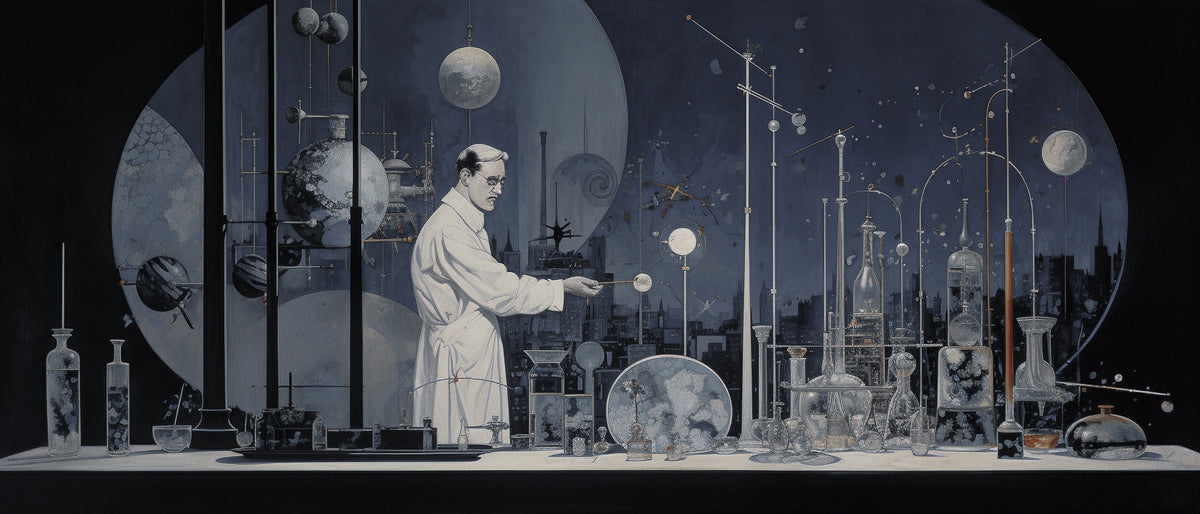
The 5-Step Fragrance Journey: From Molecule to Memory
|
|
Time to read 13 min


|
|
Time to read 13 min
Have you ever caught a whiff of a scent that instantly transported you back to a specific moment in time? Perhaps the aroma of a natural perfume reminded you of your grandmother’s garden, or a distinctive niche fragrance brought back memories of a special vacation. This powerful connection between scent and memory isn’t just coincidence—it’s deeply rooted in our biology and forms the final destination in the remarkable journey that fragrances take from their creation to their impact on our minds.
The world of niche fragrance offers a more personalized and unique scent experience than mainstream perfumes. These artisanal creations follow a fascinating path from conception to emotional impact—a journey worth exploring for anyone who appreciates the subtle art of perfumery. Let’s trace this five-step voyage that transforms simple molecules into powerful memory triggers, with special attention to how natural perfume creates some of the most evocative olfactory experiences.
What is a niche fragrance? It’s a scent created in small batches with unique ingredient combinations, often by independent perfumers who prioritize artistry over mass appeal. The journey begins in a perfumer’s laboratory, where the alchemy of scent takes its first form.
Unlike commercial fragrances that often rely heavily on synthetic compounds, natural perfume relies on botanical ingredients rather than synthetic compounds. This distinction is crucial—it’s what gives natural perfumes their distinctive character and complexity. The molecular structure of perfume determines how it interacts with your body chemistry, creating a truly personal experience.
A perfumer’s palette consists of hundreds of individual aromatic compounds. Some are isolated molecules, while others are complex natural perfume oils extracted from flowers, woods, resins, and spices. The concentration of natural perfume oils affects how long the scent will last on your skin. These building blocks are carefully selected and combined in precise proportions to create a harmonious composition.
The process resembles composing music, with different notes playing specific roles:
Top notes: The initial impression that greets your nose (typically citrus, light florals, or fresh herbs)
Heart notes: The core character that emerges after 10-30 minutes (often floral or spicy elements)
Base notes: The foundation that provides longevity and depth (usually woods, resins, or musks)
The true niche fragrance meaning lies in the story and intention behind each carefully crafted scent. When exploring niche fragrance collections, you’ll discover artisanal approaches to scent creation that prioritize quality and creativity over mass production.
Modern perfumery has evolved to incorporate sophisticated technological approaches. Today’s perfumers often follow a four-step development process:
Quantifying the target scent profile
Generating potential molecular combinations
Selecting the best-fitting components
Optimizing the final composition
The appeal of niche fragrance lies in its exclusivity and attention to quality ingredients. Many artisanal perfumers work directly with natural perfume oils to create signature scents that can’t be found in department stores. The world of ultra niche fragrance represents the pinnacle of perfume artistry and exclusivity, with some houses producing fewer than 100 bottles of a particular scent.
Once the molecular composition is perfected, the next step involves housing this liquid art in a vessel worthy of its contents. The bottle isn’t merely a container—it’s an integral part of the niche fragrance experience, the first physical connection between you and the scent.
The evolution of perfume bottles tells a fascinating story of changing aesthetics and cultural values. From ancient Egyptian alabaster vessels to ornate Victorian atomizers to the clean, architectural lines of modern flacons, perfume packaging reflects both the character of the scent and the era of its creation.
For natural perfume creators, packaging often reflects a commitment to sustainability and craftsmanship. You might find natural perfume oils housed in recycled glass bottles with wooden caps or biodegradable materials that echo the environmental consciousness behind the product.
The niche fragrance meaning encompasses both exclusivity and artistic expression through scent, and this extends to the packaging. Ultra niche fragrance houses often produce limited editions that become collector’s items, with bottles that are artistic creations in their own right. Some bottles are hand-painted, individually numbered, or created by renowned glass artists.
Cultural variations in perfume packaging reveal different aesthetic priorities:
Western designs often emphasize sleek minimalism or vintage-inspired glamour
Middle Eastern perfumes frequently feature ornate, jewel-like bottles reflecting the region’s rich perfume heritage
Japanese fragrance design tends toward elegant simplicity with perfect proportional harmony
Every element of the bottle communicates something about the scent inside. The weight in your hand, the texture of the glass, the design of the cap and atomizer—all these tactile experiences form part of your relationship with a fragrance before you even smell it.
Exploring the niche fragrance meaning reveals a world of independent perfumers creating outside mainstream trends, and their packaging choices often tell a story as distinctive as the scents themselves. The bottle becomes not just a container but a statement of values and artistic vision.
Like fine wine, perfume isn’t static—it’s a living creation that changes over time. Understanding how fragrances age helps you appreciate their evolution and ensure they remain at their best.
The aging process can enhance the depth and complexity of natural perfume oils. Natural perfume relies on botanical ingredients rather than synthetic compounds, and these natural materials often develop more interesting facets as they mature. However, this process is delicate and depends on proper storage and handling.
Several factors influence how a fragrance ages:
Oxidation: Exposure to oxygen gradually alters the molecular structure of aromatic compounds
Light exposure: UV rays can break down delicate molecules, particularly in natural perfume oils
Temperature fluctuations: Heat accelerates chemical reactions and can “cook” a fragrance
Air contact: The amount of air in a bottle increases as the perfume is used, accelerating oxidation
The complexity of natural perfume develops differently on each person’s skin, and this interaction changes as the perfume ages. Some notes become more pronounced while others recede, creating a constantly evolving olfactory experience.
Natural vs. synthetic ingredients age quite differently. The molecular structure of perfume containing primarily natural ingredients tends to develop more complexity over time, while predominantly synthetic compositions often remain more stable but may eventually “turn” suddenly.
To preserve your precious niche fragrance collection:
Store bottles in a cool, dark place (not the bathroom)
Keep them in their original boxes for extra protection from light
Avoid temperature extremes and fluctuations
Consider refrigeration for particularly valuable or delicate natural perfumes
Once opened, try to use the perfume within 1-3 years (natural perfumes) or 3-5 years (fragrances with more synthetic components)
The aging of a perfume isn’t necessarily negative—many vintage perfumes are highly sought after precisely because of how they’ve evolved over decades. The world of ultra niche fragrance often embraces this natural evolution, with some perfumers intentionally creating formulations that will develop interesting characteristics as they age.
When you spray a perfume, you transform a liquid into an aromatic cloud that interacts with your body and the surrounding environment. This transformation involves fascinating physical and chemical processes that affect how others experience your chosen scent.
The molecular structure of perfume determines how it interacts with your body chemistry. When you apply a niche fragrance, the atomizer breaks the liquid into tiny droplets that quickly evaporate. Different molecules evaporate at different rates, which is why you experience the sequential unfolding of top, heart, and base notes.
Several environmental factors influence how a fragrance diffuses and projects:
Temperature: Warmer skin increases evaporation and projection
Humidity: Higher humidity can intensify certain notes while dampening others
Air circulation: More airflow spreads the scent but can shorten its lifespan
Skin chemistry: Your unique pH and oil production affect how the fragrance develops
Creating natural perfume requires deep knowledge of essential oil interactions and how they’ll behave when applied to skin. The complexity of natural perfume develops differently on each person’s skin, making each application a unique experience.
Common application mistakes can prevent you from experiencing the full beauty of a fragrance:
Rubbing wrists together breaks down the molecular structure and flattens the scent
Applying to dry skin shortens longevity (moisturize first!)
Using too much overwhelms the nose and prevents you from appreciating subtle nuances
Spraying on clothing rather than skin prevents the full development of the fragrance
Applying in already scented areas (after using strongly scented soaps or lotions) creates clashing notes
For optimal enjoyment of natural perfume oils and niche fragrances, try these application techniques:
Apply to pulse points where blood vessels are close to the skin (wrists, neck, behind ears)
For subtle effect, spray in the air and walk through the mist
Layer unscented lotion or oil first to give the fragrance something to cling to
Consider using different fragrances for different seasons or occasions
Apply 15-20 minutes before leaving home to allow the initial alcohol evaporation and top notes to settle
The concentration of natural perfume oils affects how long the scent will last on your skin. Understanding the different concentration levels helps you choose the right format for your needs:
Parfum/Extrait (20-30% aromatic compounds): Longest lasting, most intimate projection
Eau de Parfum (15-20%): Good longevity with moderate projection
Eau de Toilette (5-15%): Lighter, fresher, with 2-4 hours of noticeable presence
Eau de Cologne (2-4%): Very light, primarily top notes, requires frequent reapplication
We’ve arrived at the most magical step in our journey—the moment when molecules become memories. The fragrance memory connection is rooted in how our brains process scent differently than other sensory inputs, and this unique pathway explains why smells can trigger such powerful emotional responses.
Unlike other senses that are processed through the thalamus before reaching higher brain regions, scent information travels directly from the olfactory bulb to the amygdala (emotion center) and hippocampus (memory center). This direct route creates an immediate, unfiltered connection between smells and our emotional experiences.
Scientists continue to study the powerful fragrance memory connection and its therapeutic applications. Research has shown that the olfactory bulb plays a crucial role in memory formation and cognitive development through complex neural circuits that adapt during learning.
This phenomenon, sometimes called the “Proust Effect” after the author’s famous madeleine cookie passage, explains why:
Childhood scent memories remain particularly vivid throughout life
Smells can trigger emotions before we consciously identify the scent
Olfactory memories often feel more emotionally charged than visual or auditory ones
Certain fragrances can instantly transport us to specific moments in time
The breathing cycle itself influences how we process and remember scents. During inhalation, we process external odor information, while exhalation is associated with memory recollection. Neuromodulators enhance circuit plasticity during the learning process, creating stronger scent-memory associations.
Understanding what is a niche fragrance helps appreciate the craftsmanship behind boutique scent creation, but understanding the neuroscience behind scent memory helps explain why these artisanal creations can have such profound personal impact.
The therapeutic applications of this knowledge are expanding. Scent is being used in clinical settings to:
Trigger positive memories in dementia patients
Reduce anxiety through aromatherapy
Enhance learning by pairing information with distinctive scents
Treat certain aspects of PTSD by creating new positive associations with trigger scents
If you’re wondering what is a niche fragrance, think of it as the olfactory equivalent of artisanal cuisine—a carefully crafted experience designed to create memorable impressions. Discovering an ultra niche fragrance that resonates with you is like finding a piece of olfactory art that speaks to your personal history and emotional landscape.
The journey from molecule to memory represents the complete lifecycle of a fragrance—from its creation in a perfumer’s laboratory to its eventual home in our emotional landscape. Each step in this process contributes to the final experience, whether you’re enjoying mainstream perfumes or exploring the more rarefied world of niche fragrance and natural perfume.
The niche fragrance meaning encompasses both exclusivity and artistic expression through scent. These artisanal creations often tell stories, evoke specific places, or capture emotional states through their carefully orchestrated progression of notes. Natural perfume relies on botanical ingredients rather than synthetic compounds, creating connections to the natural world that can feel particularly authentic and meaningful.
As you explore the world of fragrance, consider each of these five steps and how they contribute to your personal experience. The molecular composition, the bottle design, the aging process, the application technique, and the memory associations all play important roles in your relationship with a scent.
The fragrance memory connection is rooted in how our brains process scent differently than other sensory inputs. This unique neurological pathway makes perfume more than just a beauty product—it’s a powerful tool for emotional expression, memory creation, and personal identity.
These terms refer to the concentration of aromatic compounds in the solution:
Parfum/Extrait: 20-30% concentration, longest lasting, most expensive
Eau de Parfum: 15-20% concentration, good longevity and projection
Eau de Toilette: 5-15% concentration, lighter and fresher
Eau de Cologne: 2-4% concentration, very light and brief
Herz, R. S. (2016). The role of odor-evoked memory in psychological and physiological health. Brain Sciences, 6(3), 22.
Gottfried, J. A. (2011). Neurobiology of sensation and reward. CRC Press/Taylor & Francis.
Turin, L., & Sanchez, T. (2008). Perfumes: The A-Z Guide. Viking.
Aftel, M. (2014). Fragrant: The Secret Life of Scent. Riverhead Books.
Ellena, J. C. (2012). The Diary of a Nose: A Year in the Life of a Parfumeur. Rizzoli Ex Libris.
Sell, C. (2006). The Chemistry of Fragrances: From Perfumer to Consumer. Royal Society of Chemistry.
Barwich, A. S. (2020). Smellosophy: What the Nose Tells the Mind. Harvard University Press.
Dove, R. (2008). The Essence of Perfume. Black Dog Publishing.
Ackerman, D. (1990). A Natural History of the Senses. Random House.
Burr, C. (2007). The Perfect Scent: A Year Inside the Perfume Industry in Paris and New York. Henry Holt and Co.
Gilbert, A. N. (2008). What the Nose Knows: The Science of Scent in Everyday Life. Crown Publishers.
Jellinek, P. (1997). The Psychological Basis of Perfumery. Blackie Academic & Professional.
Pybus, D. H., & Sell, C. S. (1999). The Chemistry of Fragrances. Royal Society of Chemistry.
Stamelman, R. (2006). Perfume: Joy, Obsession, Scandal, Sin. Rizzoli.
Yeshurun, Y., & Sobel, N. (2010). An odor is not worth a thousand words: from multidimensional odors to unidimensional odor objects. Annual Review of Psychology, 61, 219-241.